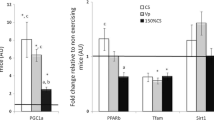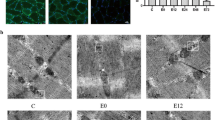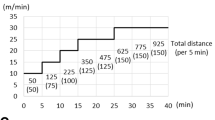Abstract
Aquaporin-3 (AQP3) is an integral membrane protein that facilitates the transport of water and glycerol across cell membranes. However, the precise localization and function of AQP3 in skeletal muscles is currently unknown. In this study, we investigated the capacity of AQP3 knockout mice to perform a single bout of exhausting exercise and analyzed the parameters related to skeletal muscle energy metabolism during exhausting exercise. Mice were exposed to a single bout of treadmill running at a speed of 12 m/min with 10° inclination until exhaustion, and sacrificed immediately, 24 h and 48 h after exercise. Both immunohistochemistry and double immunofluorescence staining revealed that AQP3 is expressed at the cell surface with no evidence of colocalization with either AQP1 or AQP4 in hamstring skeletal muscles. When exposed to a single bout of exhaustive exercise, AQP3 knockout mice fatigued more easily with the average time to exhaustion shorter than the wild-type mice. After exhausting exercise, plasma glucose, muscle glycogen, muscle triglyceride, and muscle free fatty acid levels decreased compared with the values before exercise in both AQP3 knockout and wild-type mice. However, muscle glycerol concentration after exercise decreased in the wild-type mice, but rather increased in AQP3 knockout mice. These findings suggest that decreased glycerol efflux from the skeletal muscles in AQP3 knockout mice may result in low exercise capacity, presumably due to the limitations in the constant energy supply through hepatic gluconeogenesis from glycerol during the prolonged endurance exercise.





Similar content being viewed by others
References
Badin PM, Langin D, Moro C (2013) Dynamics of skeletal muscle lipid pools. Trends Endocrinol Metab 12:607–615. doi:10.1016/j.tem.2013.08.001
Boesch C, Slotboom J, Hoppeler H, Kreis R (1997) In vivo determination of intra-myocellular lipids in human muscle by means of localized 1H-MR-spectroscopy. Magn Reson Med 37(4):484–493
Brooks G, Mercier J (1994) Balance of carbohydrate and lipid utilization during exercise: The “crossover” concept. J Appl Physiol 76:2253–2261
Coleman RA, Mashek DG (2011) Mammalian triacylglycerol metabolism: synthesis, lipolysis, and signaling. Chem Rev 111(10):6359–6386. doi:10.1021/cr100404w
Coyle EF (1995) Fat metabolism during exercise. Sports Sci Exch 8(6):1–6
Crosbie RH, Dovico SA, Flanagan JD, Chamberlain JS, Ownby CL, Campbell KP (2002) Characterization of aquaporin-4 in muscle and muscular dystrophy. FASEB J 16(9):943–949
Eng CM, Smallwood LH, Rainiero MP, Lahey M, Ward SR, Lieber RL (2008) Scaling of muscle architecture and fiber types in the rat hindlimb. J Exp Biol 211(Pt 14):2336–2345. doi:10.1242/jeb.017640
Frank MS, Nahata MC, Hilty MD (1981) Glycerol: a review of its pharmacology, pharmacokinetics, adverse reactions, and clinical use. Pharmacotherapy 1:147–160
Frigeri A, Nicchia GP, Balena R, Nico B, Svelto M (2004) Aquaporins in skeletal muscle: reassessment of the functional role of aquaporin-4. FASEB J 18(7):907–950
Frigeri A, Nicchia GP, Verbavatz JM, Valenti G, Svelto M (1998) Expression of aquaporin-4 in fast twitch fibers of mammalian skeletal muscle. J Clin Invest 102(4):695–703
Gaitanos GC, Williams C, Boobis LH, Brooks S (1993) Human muscle metabolism during intermittent maximal exercise. J Appl Physiol 75(2):712–719
Hara-Chikuma M, Verkman AS (2006) Physiological roles of glycerol-transporting aquaporins: the aquaglyceroporins. Cell Mol Life Sci 63:1386–1392
Hawley JA, Hargreaves M, Joyner MJ, Zierath JR (2014) Integrative biology of exercise. Cell 159(4):738–749. doi:10.1016/j.cell.2014.10.029
Høydal MA, Wisløff U, Kemi OJ, Ellingsen O (2007) Running speed and maximal oxygen uptake in rats and mice: practical implications for exercise training. Eur J Cardiovasc Prev Rehabil 14(6):753–760
Inoue M, Wakayama Y, Kojima H, Shibuya S, Jimi T, Hara H, Iijima S, Masaki H, Oniki H, Matsuzaki Y (2009) Aquaporin 9 expression and its localization in normal skeletal myofiber. J Mol Histol 40(3):165–170. doi:10.1007/s10735-009-9226-1
Ishibashi K, Hara S, Kondo S (2009) Aquaporin water channels in mammals. Clin Exp Nephrol 13:107–117. doi:10.1007/s10157-008-0118-6
Jelen S, Wacker S, Aponte-Santamaría C, Skott M, Rojek A, Johanson U, Kjellbom P, Nielsen S, de Groot BL, Rützler M (2011) Aquaporin-9 protein is the primary route of hepatocyte glycerol uptake for glycerol gluconeogenesis in mice. J Biol Chem 286(52):44319–44325. doi:10.1074/jbc.M111.297002
Jimi T, Wakayama Y, Inoue M (2006) Aquaporin 1: examination of its expression and localization in normal human skeletal muscle tissue. Cells Tissues Organs 184:181–187
Jones NL, Heigenhauser GJ, Kuksis A, Matsos CG, Sutton JR, Toews CJ (1980) Fat metabolism in heavy exercise. Clin Sci (Lond) 59(6):469–478
Kohut ML, Boehm GW, Moynihan JA (2001) Moderate exercise is associated with enhanced antigen-specific cytokine, but not lgM production in aged mice. Mech Ageing Dev 122:1135–1150
Lo S, Russel JC, Taylor AW (1970) Determination of glycogen in small tissues. J Appl Physiol 28:234–236
Ma T, Hasegawa H, Skach WR, Frigeri A, Verkman AS (1994) Expression functional analysis and in situ hybridization of a cloned rat kidney collecting duct water channel. Am J Physiol 266:C189–C197
Pederson BA, Cope CR, Schroeder JM, Smith MW, Irimia JM, Thurberg BL, DePaoli-Roach AA, Roach PJ (2005) Exercise capacity of mice genetically lacking muscle glycogen synthase. J Biol Chem 280(17):17260–17265
Rauch LH, Bosch AN, Noakes TD, Dennis SC, Hawley JA (1995) Fuel utilisation during prolonged low-to-moderate intensity exercise when ingesting water or carbohydrate. Pflugers Arch 430(6):971–977
Romijn JA, Coyle EF, Sidossis LS, Gastaldelli A, Horowitz JF, Endert E, Eolfe RR (1993) Regulation of endogenous fat and carbohydrate metabolism in relation to exercise intensity and duration. Am J Physiol 265:E380–E391
Skowronski MT, Lebeck J, Rojek A (2007) AQP7 is localized in capillaries of adipose tissue, cardiac and striated muscle: implications in glycerol metabolism. Am J Physiol 292:956–965
Spriet LL (2002) Regulation of skeletal muscle fat oxidation during exercise in humans. Med Sci Sports Exerc 34(9):1477–1484
Umenishi F, Verkman AS, Gropper MA (1996) Quantitative analysis of aquaporin mRNA expression in rat tissues by RNase protection assay of aquaporin mRNA expression in rat tissues by RNase protection assay. DNA Cell Biol 15:475–480
Van Loon LJ, Greenhaff PL, Constantin-Teodosiu D, Saris WH, Wagenmakers AJ (2001) The effects of increasing exercise intensity on muscle fuel utilisation in humans. J Physiol 536(Pt 1):295–304
Van Loon LJ, Thomason-Hughes M, Constantin-Teodosiu D, Koopman R, Greenhaff PL, Hardie DG, Keizer HA, Saris WH, Wagenmakers AJ (2005) Inhibition of adipose tissue lipolysis increases intramuscular lipid and glycogen use in vivo in humans. Am J Physiol Endocrinol Metab 289(3):E482–E493
Verkman AS (2005) Novel roles of aquaporins revealed by phenotype analysis of knockout mice. Rev Physiol Biochem Pharmacol 155:31–55
Wakayama Y (2010) Aquaporin expression in normal and pathological skeletal muscles: a brief review with focus on AQP4. J Biomed Biotechnol 731569. doi: 10.1155/2010/731569
Wakayama Y, Inoue M, Kojima H, Jimi T, Shibuya S, Hara H, Oniki H (2004) Expression and localization of aquaporin 7 in normal skeletal myofiber. Cell Tissue Res 316:123–129
Wakayama Y, Jimi T, Inoue M, Kojima H, Shibuya S, Murahashi M, Hara H, Oniki H (2002) Expression of aquaporin 3 and its localization in normal skeletal myofibres. J Histochem 34:331–337
Watt MJ, Heigenhauser GJ, Dyck DJ, Spriet LL (2002) Intramuscular triacylglycerol, glycogen and acetyl group metabolism during 4 h of moderate exercise in man. J Physiol 541(Pt 3):969–978
Yang B, Verbavatz JM, Song V, Vetrivel L, Manley G, Kao WM, Ma TN, Verkman VS (2000) Skeletal muscle function and water permeability in aquaporin-4 deficient mice. J Physiol 278:1108–1115
Acknowledgments
We are grateful to Dr Alan Verkman (UCSF, San Francisco, CA, USA) for providing AQP3 knockout mice. We thank Drs. Cheol Soo Choi and Shi-Young Park (Korea Mouse Metabolic Phenotyping Center, Gachon University, Incheon, Korea) for assistance with analysis of exercise training for mice. This work was supported by the Pioneer Research Center Program through the National Research Foundation of Korea funded by the Ministry of Science, ICT & Future Planning (2012-0009583).
Author information
Authors and Affiliations
Corresponding author
Additional information
Ju Hyun Lim and Dong-Hwan Kim contributed equally to this work.
Rights and permissions
About this article
Cite this article
Lim, J.H., Kim, DH., Han, D.W. et al. The effect of AQP3 deficiency on fuel selection during a single bout of exhausting exercise. Pflugers Arch - Eur J Physiol 468, 1283–1293 (2016). https://doi.org/10.1007/s00424-016-1827-4
Received:
Revised:
Accepted:
Published:
Issue Date:
DOI: https://doi.org/10.1007/s00424-016-1827-4




